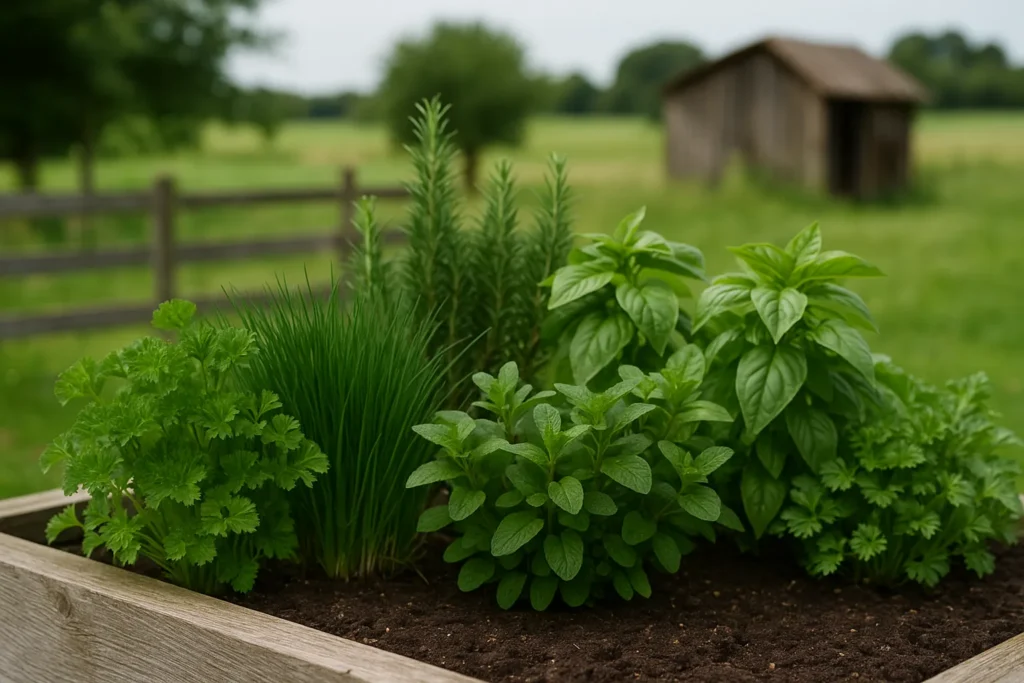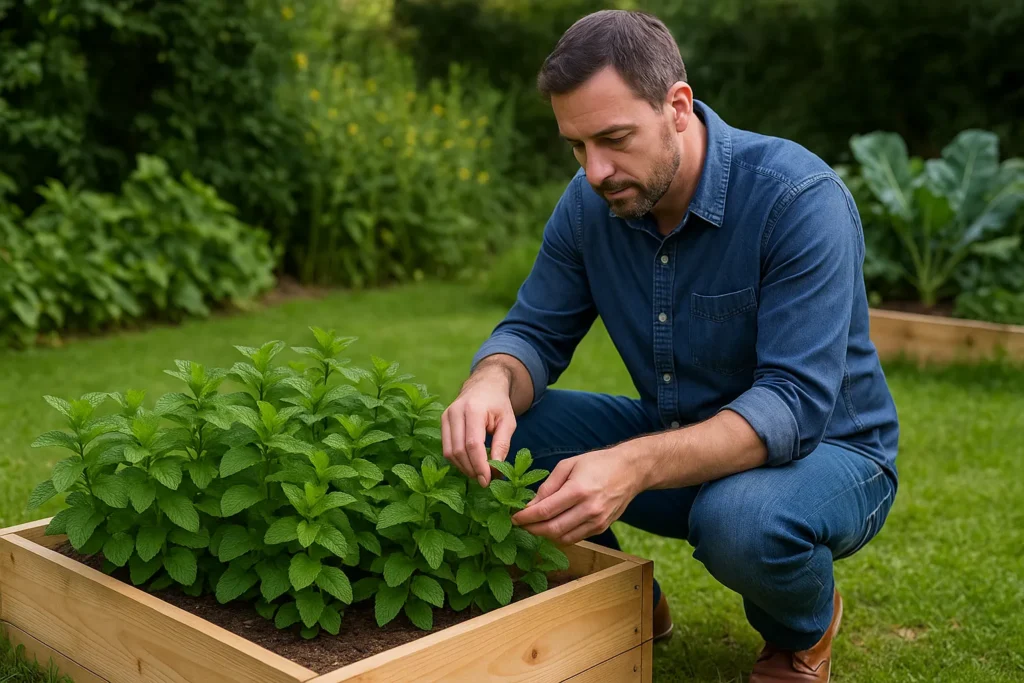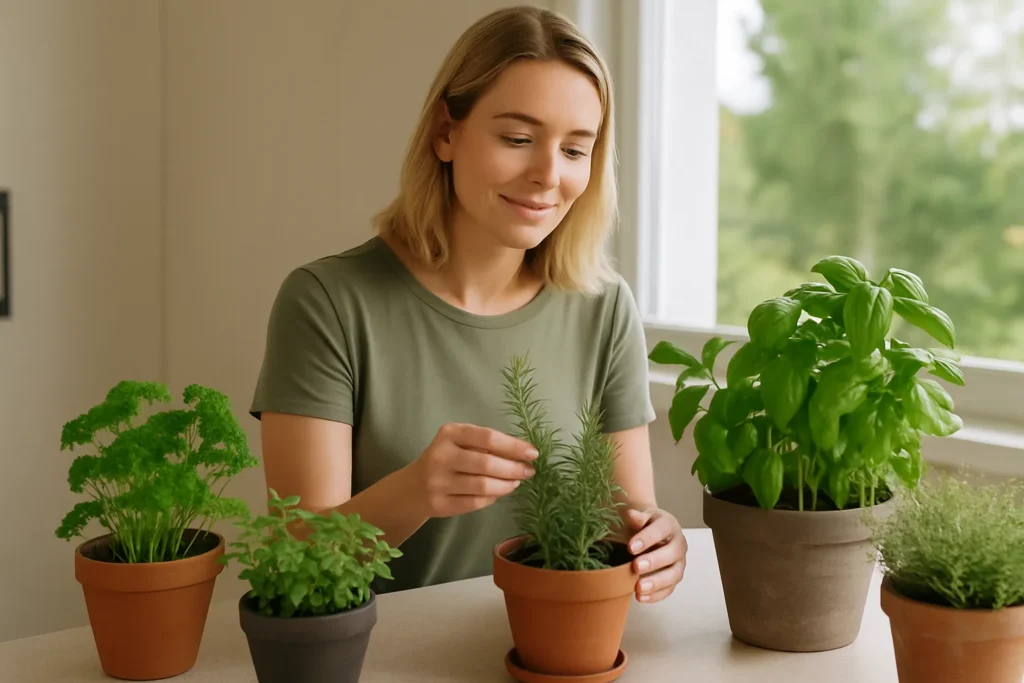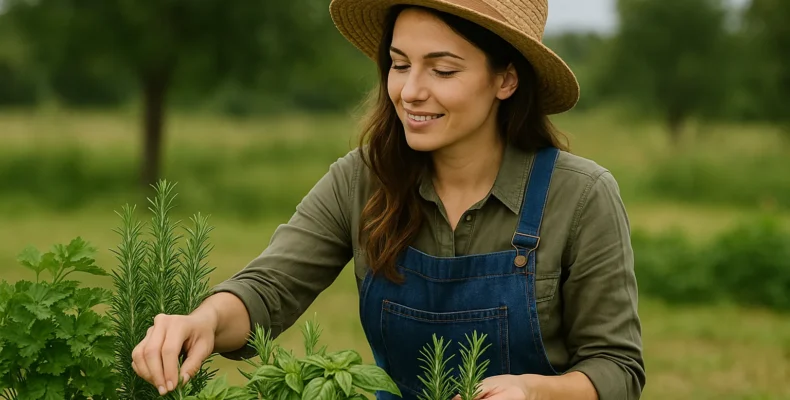You don’t need a big yard or advanced tools to grow kitchen garden herbs. A small space with sunlight and a few well-placed pots is enough to get started.
Fresh herbs add flavour to your food and a sense of satisfaction to your routine. Picking a few leaves just before cooking connects you to the process in a way that dried jars never will.
In this guide, you’ll learn how to grow the easiest herbs, care for them, and choose the right spot to plant. Each section gives you practical tips to help you build confidence as you go.
Start simple. Keep it growing. By the end, you’ll be ready to bring a fresh touch to every meal.
Building Your First Herb Garden
My first herb garden looked like a science experiment gone wrong. Three old yoghurt tubs, a patchy basil plant, and a lot of hope. But it worked eventually. If you’ve ever kept a houseplant alive, you’re already halfway there.
For beginner gardeners, herbs are one of the easiest wins. They grow fast, smell amazing, and turn bland food into something worth eating. You don’t need perfect conditions or a green thumb. A small plan and the right setup are enough to start.
Here’s where to start:
- Find a sunny spot. Most herbs need at least six hours of light per day.
- Use the right containers. Go for pots with drainage holes to avoid root rot.
- Buy decent potting mix. Skip the heavy garden soil. You want light, loose soil that drains well.
- Pick easy herbs. Basil, parsley, and mint are reliable starters with quick payoffs.
- Make it convenient. Keep your pots near the kitchen or somewhere easy to reach.
With the right conditions, even a single pot can bring a steady supply of fresh herbs. And once you see those first green shoots pushing up, you’ll want to keep growing.
It’s less about having the perfect garden and more about enjoying the process.

Garlic Chives – A Mild Twist with a Punch
Garlic chives offer the flavour of garlic without the mess. Part of the onion family, they have a milder bite and grow in long, flat stems that are easy to snip and use straight away.
They’re hardy, low-maintenance, and ideal for small pots or tight garden spaces. Once planted, they’ll handle heat and bounce back quickly after each trim.
The white flowers that bloom in late summer are more than decorative. They’re edible, lightly fragrant, and help bring bees into your garden. Bees are useful if you’re growing other herbs nearby, aren’t they?
You can use garlic chives in:
- Stir-fries
- Dumpling fillings
- Soups or broths
- Any egg dish needing a mild kick
- Simple salads, chopped fresh on top
They’re quick to grow and easy to manage. For anyone who cooks often, garlic chives can quietly earn a permanent place on your planting list.
Garden Sage – Earthy, Aromatic, and Resilient
If you forget to water your herbs now and then, garden sage might be your new best friend. It grows best in dry soil, handles neglect like a champ, and shrugs off heat without complaint.
Sage is a perennial herb, which means once you plant it, it’ll stick around for years. The leaves are thick and velvety, with a silver-green colour that adds texture to garden beds and contrasts against other plants. It doesn’t flop or spread too wide. Instead, it holds its shape like it knows exactly what it’s doing.
In the kitchen, sage adds richness to savoury dishes that need depth:
- Roast meats and poultry
- Stuffing and slow-cooked stews
- Roasted vegetables with olive oil
- Compound butters or sauces for grilled foods
It also pairs well with other herbs like thyme and rosemary, making it a strong anchor in mixed herb beds.
Pro Tip: Give it full sun, decent airflow, and a quick prune after it flowers. It’ll reward you with new growth and steady harvests without asking much in return.
Grow Mint Without Losing Control
Amy planted mint straight into her garden bed. Three months later, it had crept into the lettuce patch, climbed over the thyme, and popped up through the cracks in her paving. She swears she still finds rogue leaves near the compost bin.
If you grow mint, use a pot. Always.
It belongs to the mint family: quick-growing, shallow-rooted, and incredibly pushy. But when it’s kept in containers, it’s one of the most rewarding herbs you can grow. It bounces back after each trim, smells amazing, and looks fresh even when you forget about it for a week.
Here’s a good setup:
- A medium pot with drainage holes
- Light soil that doesn’t hold water too long
- A partly shaded spot near the kitchen door
It also makes a great ground cover in bigger tubs if you keep it trimmed around the edges. A little mint hanging over the side of a raised pot adds character without chaos.

Once established, your own herbs will always be within reach for:
- Herbal tea or iced water
- Quick dips or dressings
- Fresh topping for grilled meats or noodle bowls
Grow mint properly, and it becomes your kitchen wingman. Skip the container, and it becomes a full-time job.
Where to Plant – Flower Beds or Pots?
Australians are known for loving the outdoors, but they also want gardens that are easy to manage. According to the annual Adbri Masonry Great Australian Backyard survey, 62% of people enjoy gardening at home but lean towards low-maintenance options.
Choosing the right spot to grow herbs plays a big part in that balance. Let’s get more detailed insights.
Pots: Flexible and Foolproof
Pots are ideal for herbs that need boundaries or for growers short on space. You can manage soil, drainage, and light conditions more easily than with open ground. Herbs like mint are easier to contain this way. Pots also suit renters or anyone who wants the flexibility to move things around.
Flower Beds: For Room to Spread
If you’ve got garden space, flower beds offer herbs more breathing room. Plants like oregano and thyme love full sun and grow well when they’re spaced out properly. This option gives you natural airflow and the chance to build a larger setup over time.
Raised Beds: Great for Structure and Access
Raised beds work well for anyone who wants a tidy layout or easier access. They support strong drainage and suit mixed planting, so herbs can live alongside veggies. If bending down is tricky or you want something organised, this is a reliable option.
Annual Herbs – Seasonal Winners You Can Reseed
Annual herbs are great for beginners and anyone who likes a little change each season. These herbs grow quickly, bring bold flavours to your cooking, and let you reset and replant whenever you’re ready.
Basil, dill, coriander, and cilantro are among the most popular annual herbs. They thrive in warm weather, produce generously, and can be grown in garden beds, pots, or raised setups. These plants move fast. You’ll start harvesting within a few weeks of planting.
If you’re new to growing annual herbs, try this approach:
- Sow seeds in batches every two to three weeks
- Choose a sunny position with good drainage
- Water lightly but consistently to avoid dry-out or rot
- Start with a few seeds rather than a full bed
Dill is quick to shoot up and has soft, feathery leaves perfect for seafood or salads. Coriander tends to bolt in heat, so plant it early in spring or late in summer for better results.
The Best Herbs for Every Home Cook
When you’re deciding which herbs to grow first, it makes sense to start with the ones you’ll use the most. These are the best herbs for home cooking, and they suit just about any growing setup.

- Basil: Quick to grow and full of flavour. Perfect for pastas, sandwiches, and salads. Keep it trimmed, and it will keep producing tender, tasty leaves.
- Parsley: A hardy option that works in many dishes. A parsley plant grows well in containers or garden beds. Use it in marinades, sauces, and as a fresh topping.
- Oregano: Bold and slightly earthy. This herb plant is easy to grow, needs little water, and brings a Mediterranean edge to tomato sauces and roasted meats.
- Rosemary: Woody and fragrant with needle-like leaves. Works well in roasts, soups, and infused oils. Rosemary handles dry soil and grows into a sturdy bush over time.
- Thyme: A compact, low-growing herb that’s strong in flavour. Add it to soups, bread dough, or grilled meats. Once it takes hold, it hardly needs any care.
These herbs grow well in most parts of Australia and support a wide range of everyday cooking. Add one or two to your setup and you’ll feel the difference right away.
A Great Herb Garden Starts with You
You don’t need a massive backyard or years of gardening experience to get started. One pot, a few hours of sunlight, and a handful of seeds are enough to grow something useful.
Pick a herb you actually cook with. Plant it somewhere you’ll see often. It’s easier to care for herbs when they’re close at hand, and using your own herbs makes a noticeable difference in flavour.
Start small and grow from there. You might begin with basil or mint, but before long, you’ll be clipping fresh leaves from a handful of favourites without giving it much thought.
A great herb garden starts with one small thought. If you want more ideas to enhance your outdoor space, check out Bell Phillips Outdoor for practical guides and inspiration.
